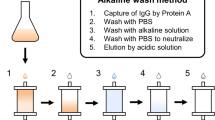Abstract
The effect of borohydride reducing reagents on monoclonal and polyclonal antibodies was examined by enzyme-linked immunosorbent assay (ELISA). Each antibody showed different stability characteristics to the reducing reagents. Sodium cyanoborohydride was at least five times milder toward immunological activity than sodium borohydride, however, sodium cyanoborohydride with a catalytic amount of metal ion (Zn2+ or Al3+ ) can be as harsh as sodium borohydride. Activated hydrophobic borohydrides, 9BBN-pyridine, did not have any advantages in respect to the stabilities of antibodies. Antibodies to be used for immunosorbent purification must be evaluated individually to determine whether their structure is stable to immobilization reagents and conditions prior to their linkage to the column support.
Similar content being viewed by others
References
Wilchek, M., Miron, T., and Kohn, J. (1984),Methods in Enzymol. 104, 3.
Vetterlein, D., and Calton, G. J. (1983),Throm. Hemostas. 49, 24.
Machuga, E., Calton, G. J., and Burnett, J. W. (1986),Toxiam 24, 187.
Kohn, J., and Wilchek, M. (1984),Appl. Biochem. Biotech. 9, 285.
Tesser, G. I., Fisch, H-U, and Schwyzer, R. (1974),Helv. Chim. Acta 57, 1718.
Peng, L., Calton, G. J., and Burnett, J. W.Enzyme Microb. Tech. (1986)8, 681.
Ohlson, S., Hansson, L., Larsson, P-O, and Mosbach, K. (1978),FEBS. Lett. 93, 5.
Roy, S. K., Weber, D. F., and McGregor, W. C. (1984),J. Chromatogr. 303, 225.
Shaehelin, T., Hobbs, D. S., Kung, H-F, Lai, C. Y., and Pestka, S. (1981),J. Biol. Chem. 256, 9750.
Larsen, D. K., Calton, G. J., and Burnett, J. W., Unpublished results.
Gaur, P. K., Anthony, R. L., Calton, G. J., and Burnett, J. W. (1982),Toxicon 20, 415.
Gidley, M. J., and Sanders, J. K. M. (1982),Biochcm. J. 203, 331.
Jentoft, N., and Dearborn, D. G. (1977),J. Biol. Chem. 254, 4359.
White, F. H., Jr. (1960),J. Biol. Chem. 235, 383.
Calton, G. J. (1984),Methods in Enzymol. 104, 381.
Author information
Authors and Affiliations
Rights and permissions
About this article
Cite this article
Peng, L., Calton, G.J. & Burnett, J.W. Effect of borohydride reduction on antibodies. Appl Biochem Biotechnol 14, 91–99 (1987). https://doi.org/10.1007/BF02798427
Received:
Accepted:
Issue Date:
DOI: https://doi.org/10.1007/BF02798427




